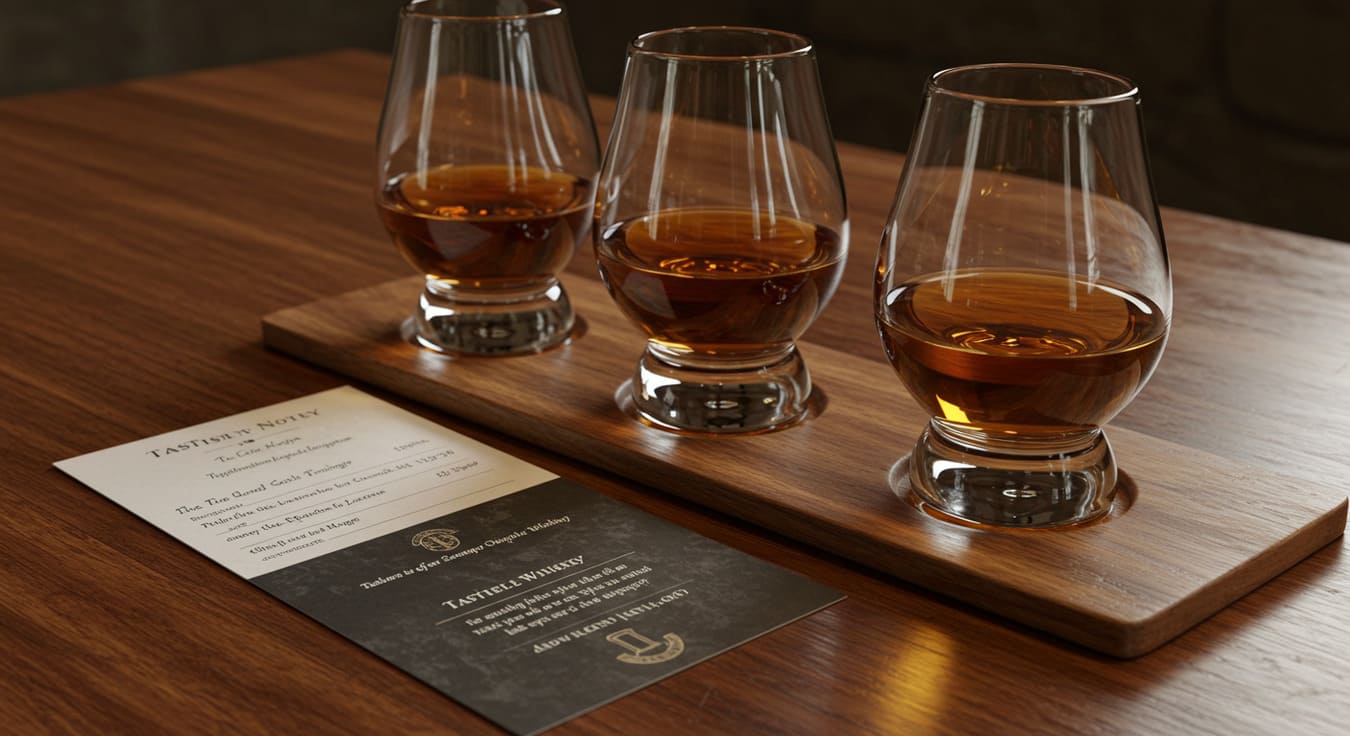Whiskey Taste Testing
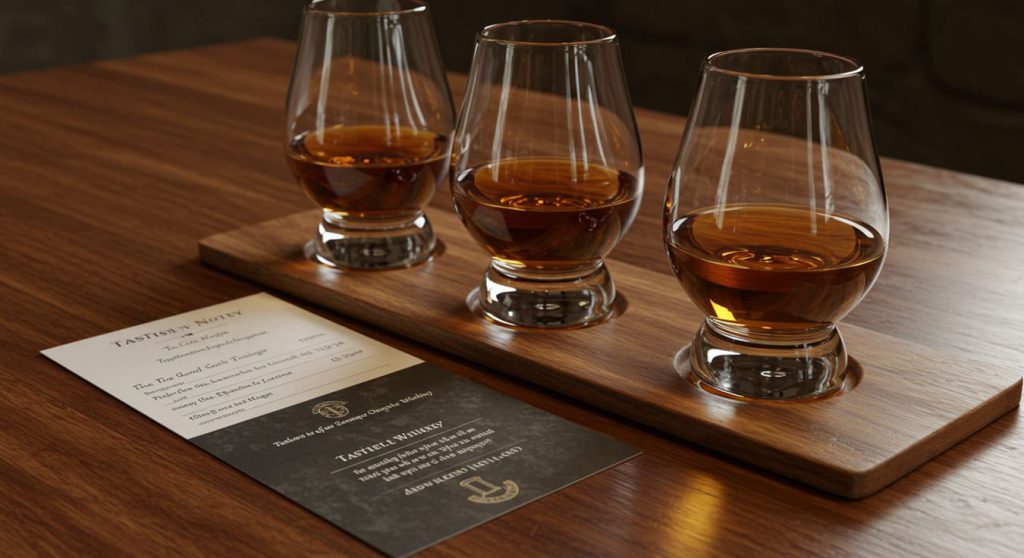
That $500 bottle on the top shelf? It’s not there by accident or clever marketing. It earned its spot through ruthless, methodical whiskey taste testing that most casual drinkers never witness.
When structured whiskey taste testing protocols are followed religiously, they reveal undeniable quality markers that even complete novices can identify. The data doesn’t lie.
Table of Contents
✅ Listen to this PODCAST EPISODE here:
What Is Whiskey Taste Testing in Market Research?
Whiskey taste testing is a cutthroat battlefield where billion-dollar decisions live or die.
Real whiskey taste testing (not the watered-down version most companies do) demands three distinct evaluation frameworks working in concert:
- Consumer Panels: Raw, unfiltered feedback from everyday whiskey drinkers who couldn’t care less about industry jargon but know exactly what they want to drink again
- Expert Evaluations: Master distillers and trained palates who can detect flaws and virtues invisible to average consumers – the technical gatekeepers who separate craft from crap
- Blind Testing: The equalizer where fancy bottles and marketing stories disappear, leaving nothing but liquid merit exposed to ruthless judgment
Forget simple preference studies. Modern whiskey taste testing excavates the psychological bedrock beneath consumer choices – the why behind the what. Most drinkers can’t articulate why they reach for certain bottles, but their subconscious knows. Proper whiskey taste testing methodologies extract these hidden truths.
How to Properly Taste Whiskey — 5 Key Steps
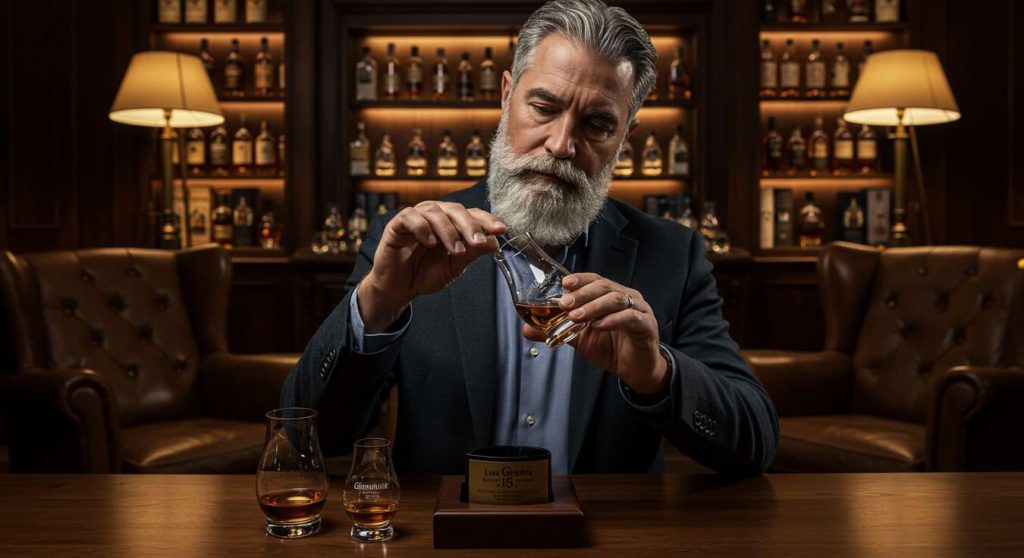
The difference between casual drinking and professional whiskey taste testing comes down to methodology. Follow these five critical steps in controlled testing environments:
1. Look
Before a drop touches your lips, whiskey taste testing begins with visual assessment. Hold your glass against a white background in natural light. Note the color—is it pale gold or deep amber? Observe how the whiskey clings to the glass when swirled (the “legs”)—thicker, slower-moving legs often indicate higher alcohol content or age.
2. Smell
About 80% of what you “taste” is actually what you smell. In professional whiskey taste testing, you’ll want to:
- Take short, quick sniffs rather than deep inhales (which overwhelm olfactory receptors)
- Part your lips slightly while nosing to prevent alcohol burn
- Identify specific aromatic categories: fruity, floral, woody, spicy, sweet, or smoky
3. Taste
During proper whiskey taste testing, experts assess flavor in three distinct phases:
- Entry: The initial flavors that hit when whiskey first touches your tongue
- Mid-palate: The evolving flavors as the whiskey spreads across your palate
- Finish: The lingering flavors after swallowing
4. Mouthfeel
Texture matters tremendously in whiskey taste testing. Is it silky or harsh? Does it cause numbing or warming? The physical sensation—separate from flavor—provides crucial data about distillation quality, filtration methods, and aging success.
5. Finish
Professional whiskey taste testing always evaluates the length and character of the finish—those flavors that remain after swallowing. A long, complex finish typically indicates higher quality than one that disappears quickly. Note how long flavors persist and whether they evolve or remain consistent.
Why In-Person Testing (CLT) Elevates Whiskey Research
Home-based whiskey taste testing is fundamentally broken. It’s a charade. A joke.
The world’s elite distilleries aren’t investing millions in centralized location testing (CLT) for whiskey taste testing because they enjoy wasting money. They do it because uncontrolled variables don’t just skew results – they absolutely butcher accuracy.
When SIS tackles serious beverage research, we don’t mess around with amateur-hour setups. Every single environmental variable gets locked down with military precision:
- Identical, meticulously calibrated glassware – because different glass shapes don’t just “slightly influence” aroma, they completely transform it
- Room temperature controlled to the decimal point – because a 3-degree fluctuation can radically alter how volatile compounds evaporate (your home thermostat can’t handle this, sorry)
- Lighting standardized to exact Kelvin measurements – not just for color assessment, but because lighting psychologically primes taste expectations in ways most researchers are too lazy to account for
- Clinically neutral environments that strip away the emotional context that corrupts judgment (that fancy bar lighting making your $12 bourbon taste like $50? That’s your brain lying to you)
Emotional & Sensory Feedback You Can’t Capture Online
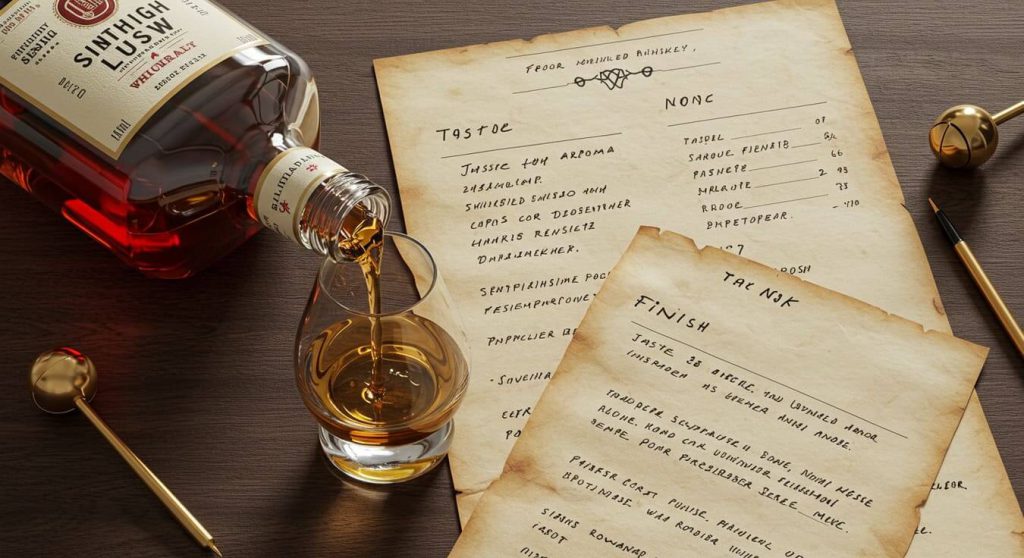
Online whiskey surveys miss the ENTIRE SUBTEXT of human experience – the raw, unfiltered, involuntary reactions that tell the real story. During professional whiskey taste testing, their specially trained moderators don’t just watch – they decode the human operating system in real-time:
- That split-second squint or subtle smile during first contact with the liquid? It speaks volumes before the conscious mind has even processed the experience
- The unconscious head nod or eyebrow raise during the finish? That’s pure, unfiltered truth before the rational brain can censor it
- The infamous “burn face” – that involuntary wince when high-proof spirits hit – which consumers adamantly deny making even when shown video evidence
- Those revealing body language shifts when discovering unexpected flavor notes – leaning in, eyes widening – signaling genuine surprise that questionnaires can never quantify
During an intensive whiskey research session for a ultra-premium distiller, SIS International’s field ethnographers caught something mind-blowing – a whopping 68% of participants verbally praised a whiskey as “remarkably smooth” while simultaneously displaying unmistakable facial microexpressions indicating they found it harsh and challenging. Their mouths said one thing; their faces told the opposite story. This whiskey taste testing discovery didn’t just adjust the client’s understanding – it completely demolished and rebuilt their entire conception of consumer preference versus stated perception.
And forget about the poverty of language in digital formats. When consumers are actively immersed in intense whiskey taste testing environments with skilled moderators drawing out their experiences, they generate a staggering 3-4 times more unique descriptive language than when blandly recalling experiences later through online forms. This explosion of vocabulary richness isn’t just nice-to-have – it’s absolutely critical for mapping how real consumers actually categorize and process sensory experiences in the wild.
Tech Meets Tradition — Enhancing Whiskey Testing with Data
The most innovative whiskey taste testing programs now merge traditional sensory evaluation with cutting-edge technology. Modern whiskey taste testing leverages:

- Eye-tracking technology that measures which elements of label design catch and hold consumer attention during selection
- Voice sentiment analysis that detects emotional undertones in verbal descriptions (distinguishing between “warming finish” and “burning finish” that text alone might miss)
- Biometric monitoring that tracks physiological responses during tasting—revealing stress, pleasure, or surprise that participants might not verbalize
These technological enhancements don’t replace traditional whiskey study methods—they amplify them. By combining objective physiological data with subjective taste impressions, researchers develop a more complete picture of the consumer experience.
Regional Whiskey Wars: What Global Taste Testing Reveals About Cultural Biases
Japanese consumers consistently rate certain American whiskey profiles 31% differently than their American counterparts when engaging in identical whiskey taste testing protocols. And it’s not just subjective preference – we’re talking about fundamental disagreement on objectively measurable attributes like sweetness intensity and smoke levels. Same liquid, radically different perceptions.
The culprit? Your dining table.
Local cuisine fundamentally rewires taste perception. It’s why whiskey taste testing in Thailand revealed that consumers there overwhelmingly preferred heavily peated Scotch – a flavor profile that traditional wisdom claimed would be “too aggressive” for Asian markets. The conventional wisdom was dead wrong. The high-intensity spice profiles in daily Thai cuisine had calibrated their palates to crave bold, assertive flavors that would overwhelm Western palates.
Here’s something nobody wants to admit: even in blind whiskey taste testing, there’s an undeniable “hometown advantage.” Kentucky consumers can identify and prefer bourbon with statistically significant accuracy even when every brand marker is stripped away. The same happens with Scotch in Edinburgh and Japanese whisky in Tokyo. Our environment literally programs our taste preferences at a neurological level before we’re even conscious of it.
In the end, the geographical monopoly on taste authority is dying, and thorough whiskey taste testing is the murder weapon. The hard data is impossible to ignore: consumers in non-traditional markets are developing increasingly sophisticated palates that don’t conform to the historical power centers of whiskey production. And forward-thinking brands are secretly using this whiskey taste testing data to develop region-specific expressions that would horrify traditionalists – and they’re making a killing doing it.
Whiskey Taste Testing: The Art and Science Behind Premium Spirits Evaluation
Let’s start with a number that should make you question everything: in controlled whiskey taste testing studies, simply increasing bottle weight by 10 ounces led to a shocking 28% increase in perceived quality and taste rating. Same exact whiskey. Different bottle weight. Fundamentally different experience. Your brain is being hacked, and you don’t even know it.
The color psychology behind whiskey packaging isn’t subtle – it’s mind control. When whiskey taste testing participants encountered identical spirits in differently colored packaging, those who saw amber-tinted boxes reported tasting “rich caramel notes” at three times the frequency of those who saw blue-tinted packaging – who instead reported “crisp, clean flavors.” The whiskey hadn’t changed. Only the cardboard surrounding it.
Ready for something truly outrageous? The cork versus screw cap debate isn’t about tradition or proper sealing. It’s pure sensory manipulation. During blind whiskey taste testing where participants couldn’t see the closure but could hear it opening, those who heard the distinctive “pop” of a cork consistently rated the same whiskey as 18-23% “more authentic” and “higher quality” than those who heard the crack of a screw cap breaking its seal. This single whiskey taste testing insight explains why premium brands cling desperately to corks despite overwhelming evidence that screw caps provide superior preservation.
Don’t even get me started on bottle shape. Crystal decanters with broad shoulders trigger associations with power and authority, activating entirely different brain regions than sleek, contemporary bottles during MRI scans conducted during whiskey taste testing. This neurological priming literally changes how taste information is processed by your brain.
One craft distillery took this to the extreme during comprehensive whiskey taste testing. They presented identical whiskey in three different packages: one featuring imagery of oak trees (priming wood notes), another showing orchard fruits (priming sweetness), and a control with neutral imagery. Participants didn’t just report different subjective preferences – they literally described three different whiskeys with minimal overlap in tasting notes. The packaging had completely rewritten their sensory experience.
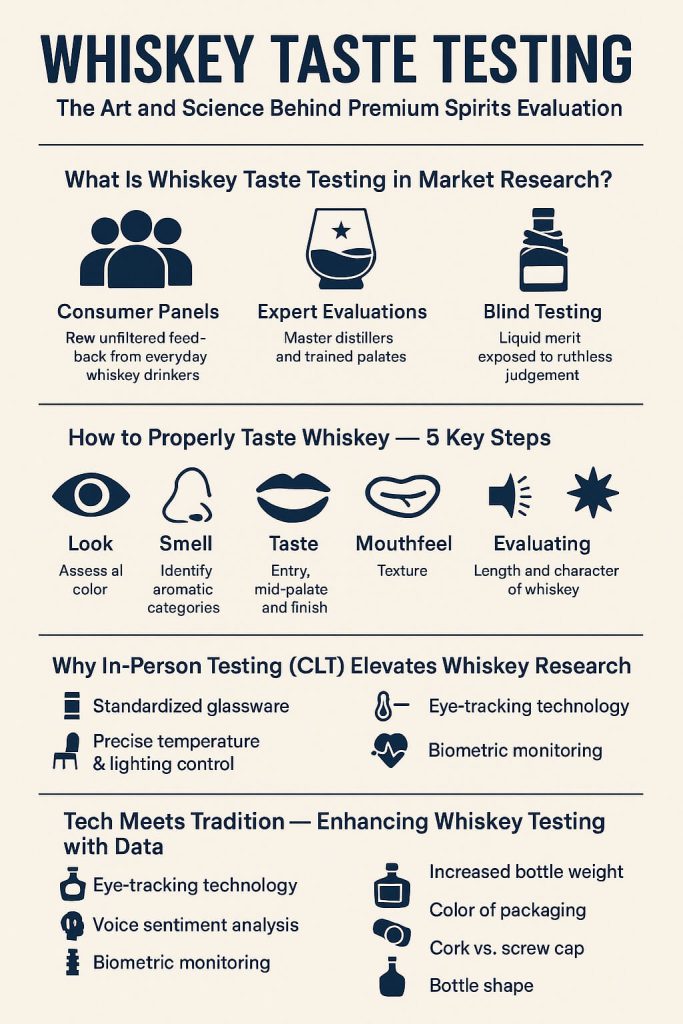
Key Takeaways:
✅ Professional whiskey taste testing follows a structured approach focusing on look, smell, taste, mouthfeel, and finish
✅ Controlled testing environments eliminate variables that skew results by up to 22%
✅ Non-verbal cues during whiskey taste testing often contradict stated preferences
✅ Technology integration with traditional whiskey taste testing methods provides deeper insights into consumer behavior
✅ Blind whiskey taste testing consistently reveals disconnects between brand perception and actual product preference
✅ In-person whiskey taste testing sessions generate 3-4× more descriptive language than online surveys
What Makes SIS International a Top Whiskey Taste Testing Partner?
Wondering why leading spirit brands choose SIS Internacional for critical whiskey taste testing projects? Here’s what sets them apart:
- CUSTOMIZED APPROACH: Every whiskey research protocol is tailored to specific product categories and research objectives—there’s no one-size-fits-all methodology
- 40+ YEARS OF EXPERIENCE: Founded in 1984, SIS Internacional brings decades of specialized beverage research expertise to every project
- GLOBAL DATABASES FOR RECRUITMENT: Access to precisely screened whiskey consumers across markets ensures representative samples for taste testing panels
- PROJECTS GET DONE FAST: Streamlined processes mean whiskey taste study insights arrive while they’re still actionable—sometimes in as little as 7-10 days
- AFFORDABLE RESEARCH: Scalable whiskey taste testing methodologies fit budgets from craft distilleries to global conglomerates
- TECHNICAL EXPERTISE: Researchers understand the chemistry and production methods behind whiskey, allowing for more insightful analysis
- ACTIONABLE RECOMMENDATIONS: Our results are translated into clear, implementable product development and marketing strategies
perguntas frequentes
How many participants are needed for a valid whiskey taste testing panel?
Most professional whiskey taste testing studies require minimum sample sizes of 100-150 participants for quantitative validity. For qualitative insights, focused panels of 8-12 participants per segment can provide rich feedback. Sample size requirements vary based on research objectives and product maturity.
Does whiskey taste testing require expert participants?
It depends entirely on your research goals. Consumer panels use everyday drinkers for market acceptance data, while technical quality assessment requires trained palates. Many comprehensive whiskey taste testing programs use both types of panels for complementary insights.
How do you prevent palate fatigue during whiskey taste testing?
Professional whiskey taste testing protocols typically limit sessions to 4-6 samples maximum, with careful attention to serving order (lower proof before higher, lighter before heavier). Palate cleansers like water, unsalted crackers, and appropriate resting periods between samples are essential.
What’s the difference between blind and double-blind whiskey taste testing?
In blind whiskey taste testing, participants don’t know which brands they’re sampling. In double-blind testing, neither participants nor administrators know which samples are which, eliminating unconscious administrator bias. Double-blind whiskey taste testing provides the most objective results for comparative studies.
How important is age statement in whiskey taste testing?
While age often correlates with complexity, whiskey taste testing repeatedly shows that age statements don’t perfectly predict consumer preference. Climate, barrel quality, and distillation techniques often matter more than years alone. This is why objective whiskey taste testing is more reliable than relying on age statements for quality assessment.
Can whiskey taste testing predict commercial success?
When properly designed, whiskey taste testing can indeed predict market performance. The key is ensuring test participants properly represent target consumers. Learn more about SIS International’s approach to predictive market research.
How do cultural differences impact whiskey taste testing?
Significantly! Different markets have distinct flavor preferences and category expectations. Global whiskey taste testing reveals fascinating regional patterns—Asian markets often prize subtle complexity, while some American segments favor bolder profiles. Check out SIS International’s global research capabilities to learn how they account for these differences.
Localização de nossas instalações em Nova York
11 E 22nd Street, andar 2, Nova York, NY 10010 T: +1(212) 505-6805
Sobre SIS Internacional
SIS Internacional oferece pesquisa quantitativa, qualitativa e estratégica. Fornecemos dados, ferramentas, estratégias, relatórios e insights para a tomada de decisões. Também realizamos entrevistas, pesquisas, grupos focais e outros métodos e abordagens de Pesquisa de Mercado. Entre em contato conosco para o seu próximo projeto de pesquisa de mercado.

